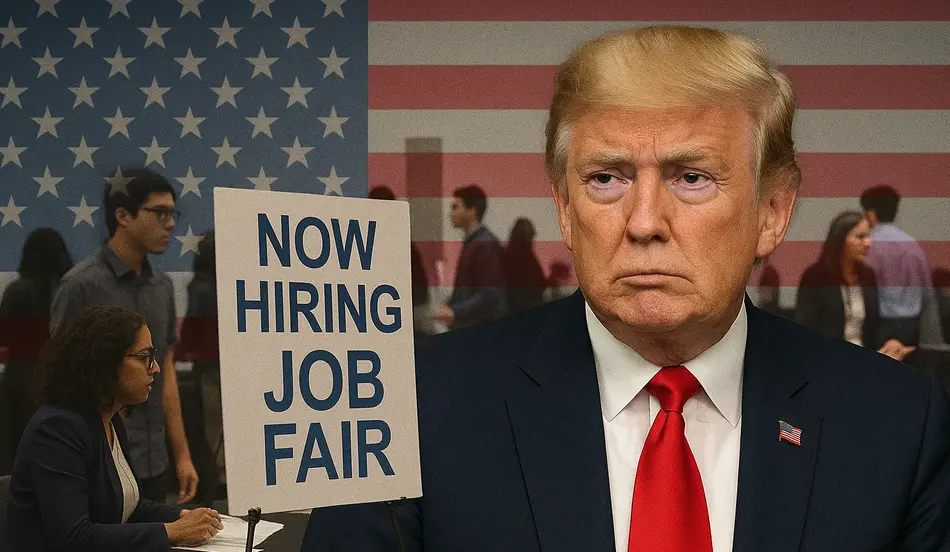The U.S. economy faced a double shock this week: a weaker-than-expected July jobs report and President Donald Trump’s sweeping new tariffs on more than 60 countries. Together, the twin developments are reshaping the outlook for growth, business confidence, and monetary policy as markets reel and policymakers brace for months of uncertainty.
The Dow Jones Industrial Average fell more than 400 points Friday morning as investors digested the data and the trade announcement. The slowdown in hiring, coupled with aggressive tariff hikes, is raising concerns among analysts about whether the U.S. economy may be entering a fragile period after several years of steady job growth.
A Jobs Report That Fell Short
According to the Labor Department, the U.S. added just 73,000 jobs in July, well below economists’ expectations. Even more concerning were downward revisions to May and June figures, which erased more than 250,000 previously reported jobs. Taken together, the revisions reveal that job growth has averaged under 100,000 per month for the past three months — a sharp decline from the robust pace of earlier in the year.
“This is not just a one-month blip,” explained CBS MoneyWatch correspondent Kelly O’Grady. “The revisions show that weakness has been building since spring. Businesses are pausing on hiring, not laying off in large numbers, but holding back because of uncertainty.”
The weak report follows signals that private-sector hiring is particularly sluggish. In June, the private sector added only 3,000 jobs, a strikingly low number. July’s figures did little to ease those concerns, suggesting that firms are reluctant to expand their workforces amid unpredictable trade policies and shifting immigration rules.
Stand Out in a Slow Hiring Market
While others hesitate, your business can move forward. Post your job on WhatJobs today and attract qualified candidates ready to work.
Post a Job Now →Tariffs Take Center Stage
While the labor market falters, President Trump is pushing ahead with new tariffs of up to 41% on imports from more than 60 countries. He described August 1 as “Liberation Day,” declaring that higher tariffs would deliver fairness for American businesses and farmers.
The tariffs will take effect in seven days for most countries, allowing customs agencies time to implement the new rates. However, Trump ordered immediate tariff hikes on Canada, raising rates on steel, aluminum, lumber, and auto imports from 25% to 35%.
The president accused Canada of unfair treatment of U.S. farmers and failing to stop the flow of fentanyl into the United States. “They’ve been charging very high tariffs, some over 200%,” Trump said. “All we want is fairness for our country.”
Canadian Prime Minister Mark Carney responded firmly, saying Canada would adapt and seek to strengthen partnerships elsewhere. “Canada will be our own best customer,” Carney said, pledging to create more high-paying jobs domestically.
Allies Caught in the Crossfire
Beyond Canada, the tariff list targeted India with a 25% increase and Switzerland with a nearly 40% hike. Smaller nations such as Syria, Laos, and Myanmar faced tariffs above 40%, though trade volumes with those countries are limited.
Mexico, however, received a 90-day extension before its tariffs increase, signaling softer treatment for America’s southern neighbor compared with Canada. Analysts suggest the White House views Mexico as more willing to negotiate.
“These moves are part of a broader strategy,” said CBS political reporter Zak Hudak. “The administration admits the uncertainty created by tariffs is being used as leverage in trade negotiations. The goal is to make trading partners uncomfortable enough to concede.”
White House Response to Weak Jobs Numbers
Despite the disappointing jobs data, the White House sought to emphasize positives. Press Secretary Karoline Leavitt issued a statement noting that inflation has cooled, wages are rising, and unemployment remains stable. She also renewed pressure on Federal Reserve Chair Jerome Powell to cut interest rates.
Steve Myron, chair of the Council of Economic Advisers, acknowledged the jobs report was “not exactly what we wanted to see,” but argued that uncertainty from tariffs was a necessary negotiating tactic.
The message from the administration: short-term discomfort is a price worth paying for longer-term trade concessions.
Business Reaction: Holding Back on Hiring
For many businesses, tariffs are a direct hit to their bottom line. Importers face higher costs on goods ranging from washing machines to steel. Initially, some firms absorbed the tariffs, but as prices rise, more costs are passed on to consumers.
Companies are cautious about expanding payrolls under such conditions. “Firms don’t know how their costs are going to change in the coming months,” O’Grady explained. “So they hold off on new hires rather than risk higher labor expenses when input prices are uncertain.”
Some sectors, particularly those reliant on global supply chains, are delaying investment decisions altogether. While layoffs remain limited, the slowdown in job creation signals growing unease.
The Federal Reserve’s Dilemma
The jobs slowdown arrives just as the Federal Reserve weighs its next move on interest rates. Powell and fellow policymakers left rates unchanged at their most recent meeting, citing still-healthy labor conditions and concerns about inflation. But with hiring weakening, the pressure is mounting.
Economists note that the Fed’s last rate-cut cycle began after three months of weak jobs reports — the same trend emerging now. “This makes the case for a potential rate cut in the next meeting or two,” O’Grady said.
Trump has repeatedly called for rate cuts, arguing they would spur investment. Powell, however, insists the Fed must balance inflation concerns with labor market realities. With inflation ticking higher in the latest report and tariffs likely to push prices up further, the Fed faces a complex decision.
Canada at the Center of the Storm
The most politically charged development may be the tariff escalation against Canada. As America’s third-largest trading partner and a longtime ally, Canada’s economic ties to the U.S. are deep and multifaceted.
Carney has hinted at diversifying trade relationships, but Canada remains heavily dependent on U.S. markets. The abrupt tariff hike on lumber, autos, and metals could significantly disrupt cross-border supply chains.
Some Canadian officials fear Trump’s hardline stance may be designed to increase pressure on Ottawa to consider deeper integration with the U.S. — even revisiting his past suggestion that Canada could become America’s “31st state.” While not currently on the table, the rhetoric underscores how strained the relationship has become.
Markets Signal Concern
Investors are clearly unnerved. The Dow fell more than 400 points in early trading, while the S&P 500 and Nasdaq also declined sharply. Analysts say markets are digesting both the weak jobs data and fears that tariffs could accelerate an economic slowdown.
The selloff reflects broader worries that businesses are losing confidence. With fewer hires, weaker private-sector growth, and tariffs raising costs, the path forward looks increasingly uncertain.
What’s Next?
All eyes now turn to the Fed’s upcoming meetings, the next set of inflation data, and whether tariff negotiations yield any breakthroughs. If businesses continue to hold back on hiring and consumers tighten their spending, the risk of a slowdown could deepen.
For now, the administration insists its strategy will pay off. “We wanted to make ourselves a little uncomfortable as leverage,” Myron said, emphasizing that discomfort is part of the plan.
But for American workers and businesses facing higher costs, delayed hiring, and volatile markets, the short-term pain is already real.
FAQs
1. Who ultimately pays for Trump’s new tariffs?
Although tariffs are collected from importers at U.S. ports, the costs are often passed on to consumers through higher prices. Businesses may absorb part of the burden initially, but over time, Americans pay more for imported goods.
2. Why did job growth slow so sharply in July?
Economists cite multiple factors: uncertainty over tariffs, tighter immigration policies reducing the pool of available workers, and more cautious consumer spending. Many businesses are pausing hiring until they have clarity on future costs.
3. Could the Federal Reserve cut interest rates soon?
Yes. The Fed has historically cut rates after several months of weak jobs data. With inflation edging higher and tariffs raising costs, the Fed faces a difficult balancing act, but analysts say a rate cut in the next meeting or two is increasingly possible.
4. What does the tariff escalation mean for U.S.–Canada relations?
The immediate 35% tariffs on Canadian imports have strained relations with America’s northern ally. Canada has pledged to diversify its trade partnerships but remains deeply tied to the U.S. economy. Negotiations are expected to continue, though tensions are high.




